
The Secretary of the Navy toured a historic California shipyard facility on Oct. 2 after calling for a new maritime statecraft that includes finding ways to improve the U.S. shipbuilding industry. The Mare Island Dry Dock in Solano County, Calif., provides dry docking and pier-side vessel repair, maintenance and alterations services on part of a former naval repair shipyard, the Mare Island Naval Shipyard. Secretary of the Navy Carlos Del Toro toured the facilities with Rep. John Garamendi (D-Calif.), whose…

 By
By 











